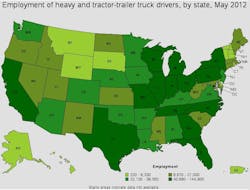The Benefits of Sending Truck Drivers Home for the Holidays
With the number of available drivers at an all-time low – driver turnover rates are at 99% – carriers are doing everything in their power to recruit and retain drivers. One incentive an increasing number of transportation companies are providing for drivers during the holiday season is “due home driving.”
The concept of due home driving is simple: during the holidays, carriers will make an effort to book inbound loads for drivers to their home states, thus ensuring their drivers are home for the holidays with their families.
This incentive is more crucial than ever before because of the aging driver workforce. Today, the average age of a trucker driver is 48 years old. Over 20 percent of truck drivers are between the ages of 55 to 65, and fewer than 8 percent are 25 to 29. With the majority of the workforce being middle-aged, the likelihood of having a family to go home to during the holidays is high, further cementing the importance of due home driving.
Due home driving is also beneficial for shippers. In the days before a family-oriented holiday like Thanksgiving or Christmas, carriers are searching for load assignments that will take their drivers back to their home states. This means lower prices for shippers during these times – but only to those states in which the drivers reside. According to the Bureau of Labor Statistics (shown in the map above), the majority of U.S. heavy and tractor-trailer truck drivers reside in Texas, California and Florida. Shippers can take advantage of below market pricing into these states in the days leading up to major holidays. On an average inbound shipment to California, we typically see a 30 percent decrease in price between December 22nd and December 25th compared to rates from the rest of the month.
Despite the cost benefits, there are some drawbacks to due home driving for shippers. With so many trucks heading to drivers’ home states, it can become extremely difficult to procure capacity in states where fewer drivers reside. This means that a shipment to New England or Montana, for example, could be exponentially more expensive and difficult to schedule during this time.
However, shippers are not without options. When shipping to states with lower truck driver populations, shippers should consider intermodal shipping. When OTR capacity is scarce, intermodal is a strong alternative because it is cost-effective, environmentally-friendly and does not rely as heavily upon drivers’ schedules.
With driver turnover rates continuing to rise, carriers know that they must invest in keeping the drivers they have and recruiting new drivers to join their team. By implementing due home driving, carriers show their workforce that they not only value their services, but that they are continually trying to improve their employees’ quality of life. This creates some advantages – and some difficulties – for shippers, but most importantly allows drivers time with their family at the holidays.
Robert Peck is director of operations for Load Delivered Logistics. He is responsible for the design, implementation and management of operational process.

